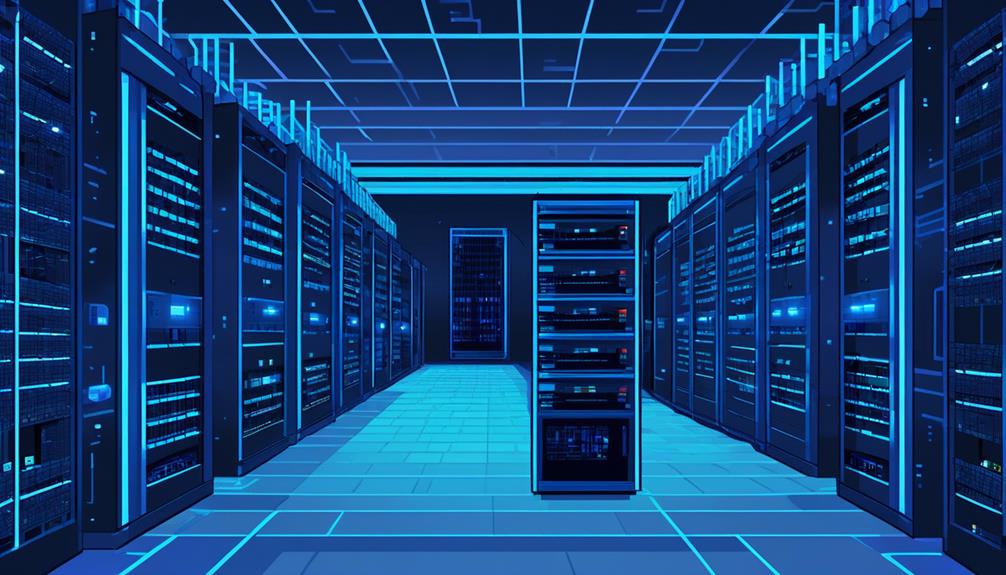Power management in data centers is a critical aspect of maintaining efficient operations and minimizing costs. With the increasing demand for data processing and storage, data centers consume substantial amounts of electricity, making effective power management essential.
From monitoring and optimizing power consumption to implementing redundancy measures and considering future growth, there are numerous factors to consider.
This discussion will explore the importance of power monitoring, determining power requirements, the role of redundancy and backup systems, scalability in power management, best practices, tools for efficiency, current and emerging trends, and industry energy standards.
By understanding the intricacies of power management in data centers, organizations can enhance their operational efficiency, minimize downtime, and contribute to a more sustainable future.
Key Takeaways
- Power management is essential for optimizing resources, reducing costs, and ensuring efficient management in data centers.
- Accurate power requirements are determined by estimating IT load, cooling system power needs, and supporting infrastructure usage.
- Three-phase power systems offer higher capacity and efficiency compared to single-phase power, making them ideal for data centers with high energy consumption.
- Redundancy and backup systems, such as UPS and backup generators, are crucial for uninterrupted operation and safeguarding critical IT equipment.
Importance of Power Monitoring
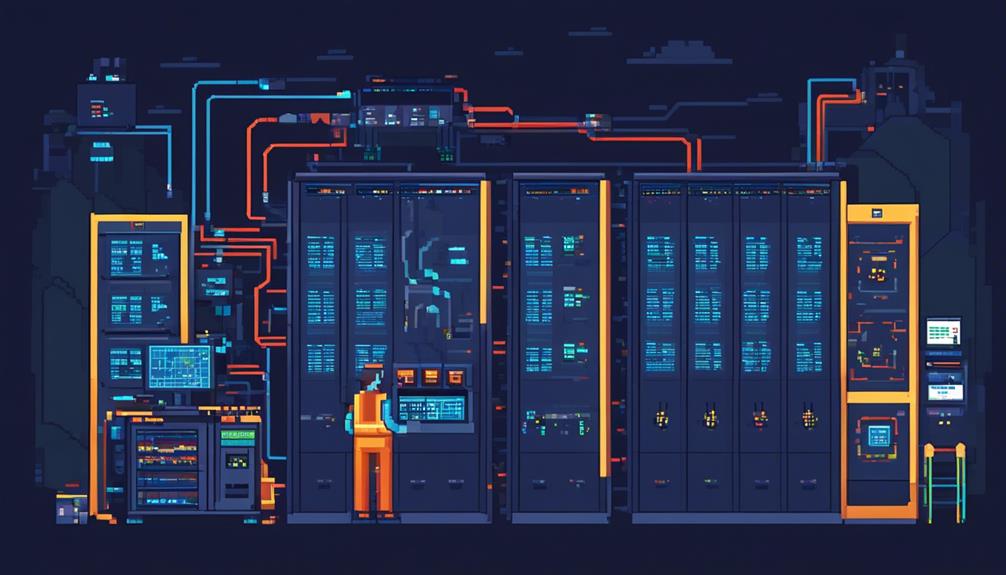
Power monitoring plays a crucial role in data center operations by providing valuable insights into power usage, enabling optimization of resources, and ensuring efficient and sustainable power management. In the data center industry, power management is of utmost importance due to its impact on operational costs, capacity planning, and environmental sustainability.
Power monitoring helps data center operators understand and determine power requirements accurately. By estimating the IT load, cooling system power needs, and supporting infrastructure power usage, data center managers can make informed decisions regarding power allocation and capacity planning. Additionally, considering future growth is essential to ensure that the power infrastructure can accommodate increasing demands.
Understanding the power distribution process is another critical aspect of power monitoring. The understanding of concepts such as amps, volts, ohms, and watts is necessary to accurately measure and analyze power usage. Power distribution units (PDUs) play a significant role in dispensing electricity throughout the data center, making it crucial to monitor their performance and efficiency.
Implementing an Intelligent Power Management (IPM) system can further optimize power distribution in data centers. By leveraging advanced technologies and automation, IPM systems help reduce costs, improve energy efficiency, and minimize downtime. These systems provide real-time monitoring, alerting operators to any irregularities or potential issues, allowing for prompt action and prevention of power-related disruptions.
Effective power management is vital for data center operations, impacting pricing, energy efficiency, and the prevention of energy disruptions. Energy-efficient practices and the use of uninterruptible power supply (UPS) systems are essential for maintaining uninterrupted operations and protecting critical data.
Determining Power Requirements
To accurately assess the power requirements of a data center, it is crucial to carefully estimate the IT load, cooling system power needs, and supporting infrastructure power usage. Let's delve into each of these areas in detail:
Estimating the IT load:
- Determining the IT load is essential to understand the amount of power required to run the servers and other IT equipment in a data center. This involves assessing the power consumption of individual servers, storage devices, networking equipment, and other components.
- Consideration should be given to factors such as server utilization, peak workloads, and the type of applications running on the servers. This information helps in accurately estimating the power needs of the IT equipment.
Cooling system power requirements:
- Cooling systems play a critical role in maintaining optimum temperatures within a data center. It is important to accurately determine the power requirements of the cooling systems to prevent overheating and ensure the smooth operation of the IT equipment.
- Factors such as the size of the data center, the type of cooling technology used, and the ambient temperature of the location need to be considered when estimating the power needs of the cooling systems.
Supporting infrastructure power usage:
- Supporting infrastructure components, including lighting, ventilation, and security systems, also consume power in a data center. It is essential to calculate the power requirements of these components to determine the overall power needs of the data center accurately.
- Redundancy in the power system, achieved by duplicating critical components, is also crucial to ensure continuous uptime and reliability.
Single-Phase Vs Three-Phase Power
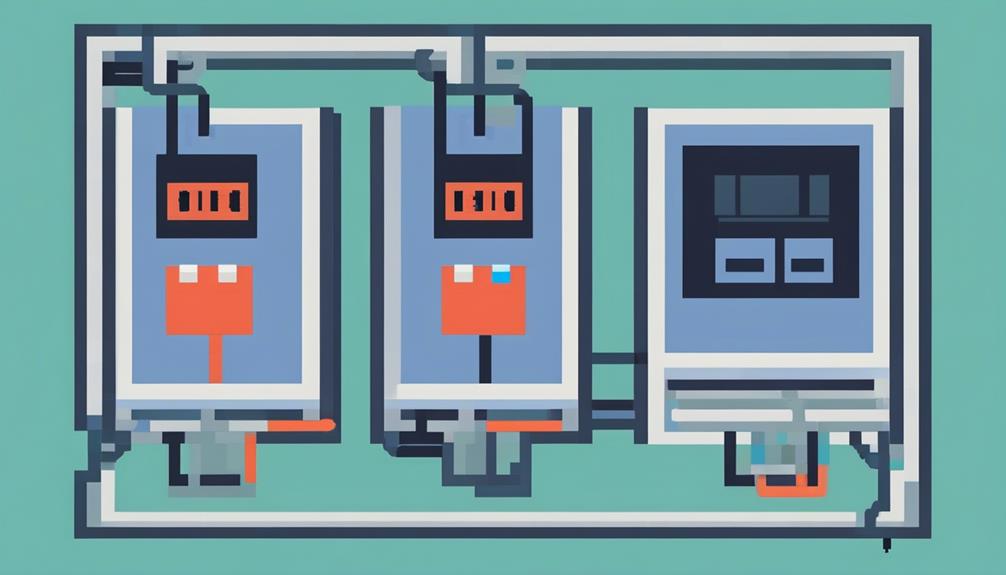
In order to effectively manage power distribution in data centers, it is important to understand the key differences between single-phase and three-phase power systems.
Single-phase power is a two-wire alternating current (AC) power circuit, commonly used in smaller applications. On the other hand, three-phase power is a three-wire AC power circuit that is typically used in larger industrial and commercial settings.
One of the main advantages of three-phase power is its ability to provide a more constant and balanced power supply compared to single-phase power. This is due to the fact that three-phase power systems have three separate conductors, each carrying a different phase of the AC waveform. As a result, the power supply is smoother and more stable, which is crucial for the reliable operation of data center equipment.
Three-phase power systems also offer higher power capacity and efficiency. With three separate phases, three-phase power can deliver more power compared to single-phase power systems. This makes three-phase power ideal for data centers that require high energy consumption and have a large number of servers, storage devices, and networking equipment.
While single-phase power systems are simpler and less expensive to install, they may not be suitable for data centers that have high power demands. In such cases, three-phase power systems, along with appropriate power management and UPS systems, are recommended to ensure a reliable and efficient power supply.
Redundancy and Backup Systems
Redundancy and backup systems play a critical role in ensuring uninterrupted and reliable power supply in data centers. By duplicating critical power infrastructure components and systems, these measures are designed to safeguard against failures or outages.
Here are some key considerations regarding redundancy and backup systems in data centers:
- Backup power systems: Uninterruptible Power Supplies (UPSes) and backup generators are essential components of backup systems in data centers. UPS systems provide immediate backup power in the event of a power failure, ensuring continuous operation until the backup generators kick in. This backup power is crucial for preventing disruptions and protecting sensitive IT equipment.
- Redundancy in power distribution: Power distribution units (PDUs) and automatic transfer switches (ATSes) are key components that help ensure consistent power availability to the IT equipment in a data center. Redundancy in these systems means that there are duplicate PDUs and ATSes, so if one fails, the backup takes over seamlessly. This redundancy prevents downtime and ensures uninterrupted power supply to critical IT equipment.
In addition to these measures, data centers also leverage power management software to monitor and manage power usage effectively. This software provides real-time information on power consumption, allowing data center operators to optimize energy usage and identify potential issues before they cause disruptions.
Understanding the importance of redundancy and backup systems is crucial for maintaining operational continuity and preventing costly disruptions in data center operations. By implementing these measures, data centers can ensure uninterrupted power supply, safeguard critical IT equipment, and maintain the reliability and availability of their services.
Scalability in Power Management
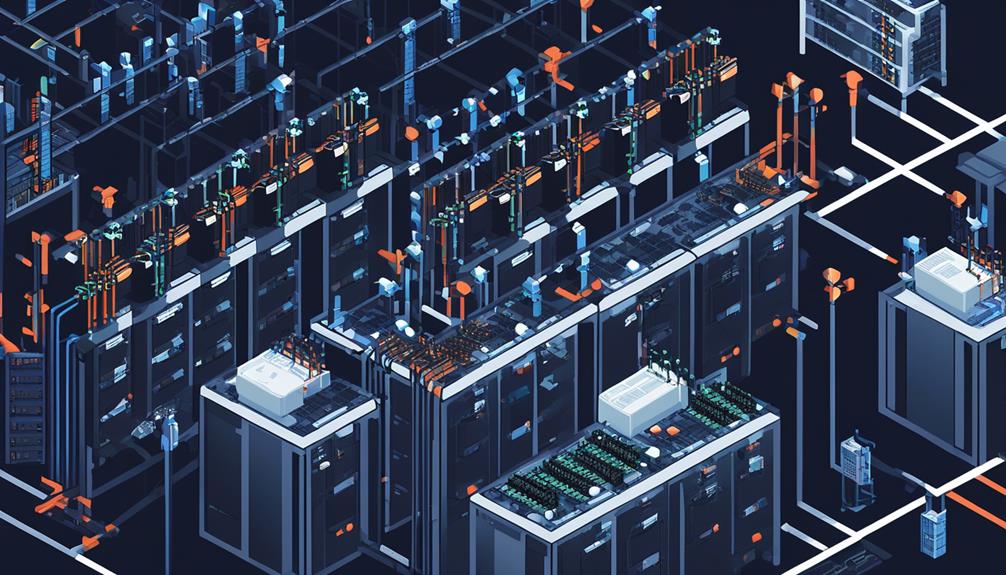
Efficiently managing power scalability is a critical aspect of data center operations, ensuring the ability to handle increasing power demands as the facility expands. Scalability in power management involves designing a system that can efficiently accommodate growing power consumption while maintaining energy efficiency and reliability. This requires careful consideration of UPS systems, power supply, and distribution systems.
One key aspect of power scalability is the ability to add more power capacity as the data center expands. This can be achieved through the installation of additional UPS systems and power distribution units. These systems should be designed with redundancy in mind to ensure uninterrupted power supply in the event of a failure. Redundancy not only improves the reliability of the power infrastructure but also allows for maintenance and upgrades without disrupting critical operations.
Another important factor in power scalability is the flexibility to adapt to changing power needs. Data centers often experience fluctuations in power consumption due to varying workloads and equipment configurations. Therefore, a scalable power management solution should be able to adjust power supply and distribution accordingly to optimize performance and energy efficiency.
Implementing scalable power management solutions is crucial for accommodating evolving IT loads and maintaining reliable power distribution within the data center. It reduces the risk of power outages and improves overall operational efficiency. Furthermore, a well-designed power scalability plan ensures the sustainability of the data center by considering future growth in power requirements and providing the necessary infrastructure to support it.
To summarize, power scalability is a critical aspect of data center power management. It involves designing a system that can efficiently handle increasing power demands, accommodate changing power needs, and ensure reliable power supply and distribution. By implementing scalable power management solutions, data centers can optimize performance, reduce operating costs, and ensure sustainability as they expand.
Power Distribution Strategies
To ensure uninterrupted power supply and efficient utilization within a data center infrastructure, effective power distribution strategies play a crucial role in managing increasing power demands and accommodating changing power needs. Power distribution strategies encompass various elements such as redundancy, power density, and power capacity.
Here are two key aspects to consider when implementing power distribution strategies in data centers:
- Power Requirements Planning:
- Accurate estimation of power requirements is essential for effective planning. This involves considering the IT load, cooling system power, and supporting infrastructure power.
- Future growth should also be taken into account to ensure that the power distribution system can accommodate expanding power demands.
- Components and Systems:
- Key components of power distribution in data centers include power cables, breakers, UPS systems, backup generators, and automatic transfer switches. These components work together to ensure reliable power supply and minimize downtime.
- Power management systems play a vital role in monitoring and controlling the power distribution system, enabling efficient utilization and identifying potential issues before they escalate.
Implementing energy efficiency strategies is also important in power distribution. This includes integrating renewable energy sources and using energy-efficient hardware to reduce power consumption. Monitoring power usage effectiveness allows data center operators to identify areas for improvement and optimize energy usage.
Understanding power needs involves considering metrics such as amps, volts, ohms, and watts. Power distribution units (PDUs) play a significant role in managing power capabilities within data centers, dispensing electricity to various equipment and ensuring balanced power distribution.
Cost Considerations in Power Management
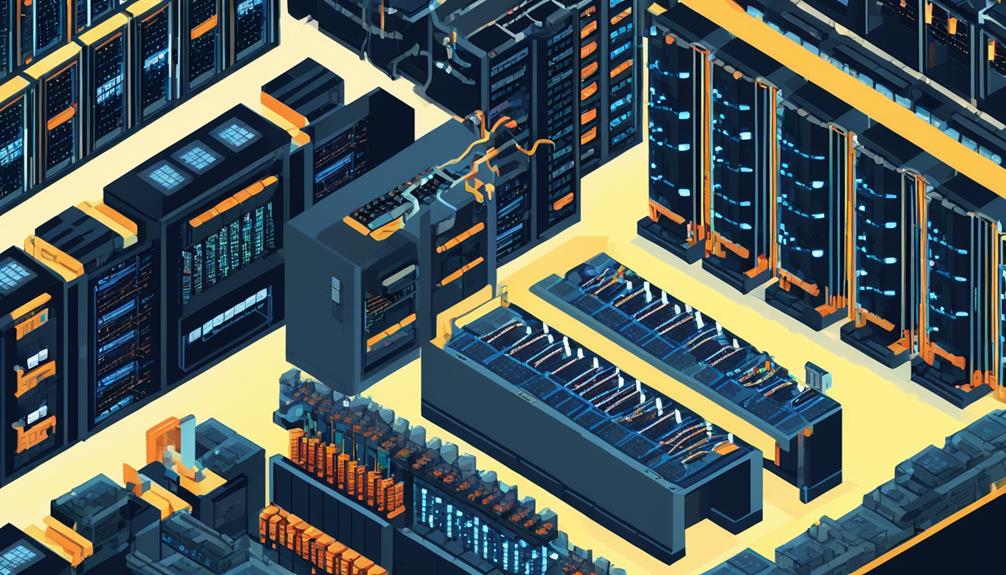
Cost considerations are a critical aspect of power management in data centers, requiring careful evaluation and optimization of power usage to minimize operational expenses. Understanding power metrics such as power density, capacity, efficiency, and distribution is crucial for cost-effective power management in data centers.
One key area where cost considerations play a significant role is power consumption. Monitoring and optimizing power usage, especially in cooling systems, can lead to substantial cost savings. By implementing energy-efficient cooling strategies, such as using hot aisle/cold aisle containment, variable speed fans, and economizers, data centers can reduce their energy consumption and operating costs.
Another cost consideration is the selection and maintenance of UPS (Uninterruptible Power Supply) systems. UPS systems provide backup power during utility outages, ensuring continuous uptime. However, these systems can be expensive to operate and maintain. It is important to evaluate the efficiency and reliability of UPS systems to minimize energy waste and reduce operational costs.
Cost considerations also extend to power distribution systems. Choosing the right distribution components, such as cables, breakers, and backup generators, is crucial for reliable power delivery to IT equipment. Investing in high-quality components upfront can reduce maintenance costs and prevent power disruptions that can result in financial losses.
Lastly, considering future growth and employing redundancy are essential cost considerations in power management. By accurately estimating future power requirements and implementing scalable solutions, data centers can avoid costly retrofitting or capacity expansions in the long run.
Best Practices for Power Management
To optimize power management in data centers and ensure energy efficiency, there are several best practices that can be implemented:
- Design and layout considerations:
- Plan the data center layout to minimize power distribution losses and reduce cable lengths.
- Implement hot aisle/cold aisle containment to improve airflow and reduce cooling requirements.
- Use energy-efficient server racks and cabinets that enhance airflow management.
- Efficient power distribution systems:
- Deploy high-efficiency uninterruptible power supply (UPS) systems to minimize power loss during AC to DC conversion.
- Utilize power distribution units (PDUs) with built-in energy monitoring capabilities to track and manage power usage.
- Optimize power distribution paths to minimize electrical losses and ensure a reliable power supply.
- Monitoring and management strategies:
- Implement real-time power monitoring systems to identify and address areas of excessive power consumption.
- Utilize power management software to automate power provisioning and optimize workload distribution.
- Regularly measure and track Power Usage Effectiveness (PUE) scores to assess the overall energy efficiency and identify areas for improvement.
- Reduce power consumption:
- Consolidate servers and virtualize applications to optimize resource utilization and reduce power requirements.
- Implement power management features such as dynamic frequency scaling and server power capping to regulate power consumption during periods of low utilization.
- Deploy energy-efficient hardware components, including processors, memory modules, and storage devices.
Tools for Efficient Power Management
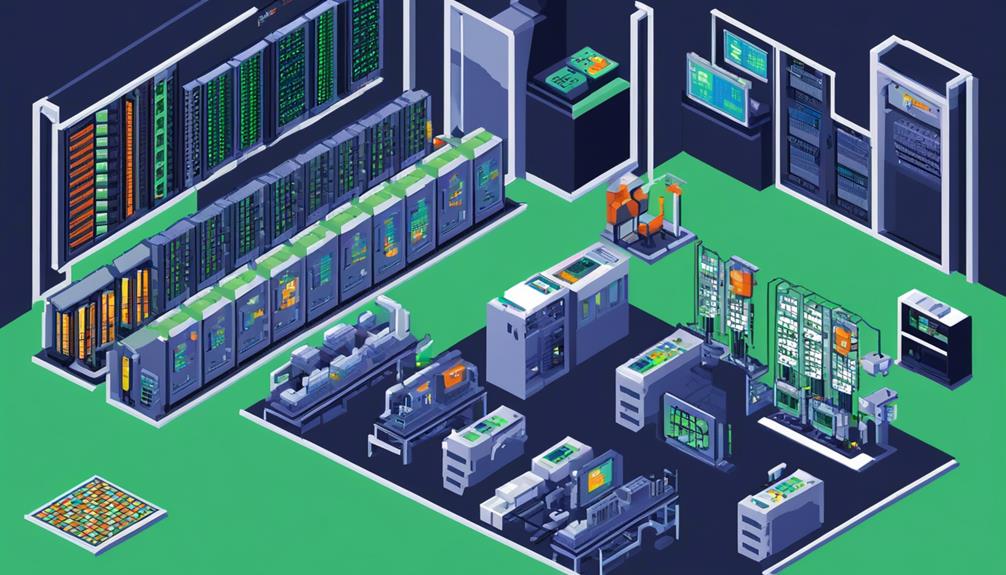
Efficient power management in data centers can be achieved through the utilization of various tools designed specifically for this purpose. These tools are instrumental in optimizing energy usage, ensuring uninterrupted power supply, and enhancing overall efficiency. One such tool commonly employed in data centers is the Uninterruptible Power Supply (UPS) system. UPS systems play a critical role in providing backup power during utility outages and voltage fluctuations, allowing for seamless operations and preventing data loss. These systems are designed to deliver reliable and continuous power to the data center infrastructure, ensuring uninterrupted operations and protecting critical equipment.
In addition to UPS systems, data centers also employ various energy management tools and technologies to monitor and optimize energy usage. Power distribution units (PDUs) with built-in metering capabilities provide real-time data on power consumption, allowing administrators to identify power-hungry devices and implement energy-saving measures. Furthermore, intelligent power management software enables data center operators to monitor and control power distribution, regulate cooling systems, and identify areas for improvement.
Advanced tools such as power analytics platforms utilize machine learning algorithms to analyze power usage patterns, identify inefficiencies, and provide actionable insights for optimization. These platforms enable data center operators to make informed decisions regarding power provisioning, equipment placement, and cooling infrastructure design, resulting in enhanced energy efficiency and cost savings.
Efficient power management in data centers is crucial for reducing operational costs, minimizing environmental impact, and maximizing uptime. By leveraging tools and technologies specifically designed for power management, data center operators can achieve significant improvements in efficiency, reliability, and sustainability. With the increasing demand for data processing and storage, the adoption of these tools will continue to be essential in the future of data center operations.
Current and Emerging Trends in Power Management
Renewable energy integration, liquid cooling technologies, direct current power distribution, artificial intelligence integration, and energy storage systems are among the current and emerging trends shaping power management in data centers.
These trends are driven by the need for increased energy efficiency, reduced carbon footprint, and improved reliability of data center operations. Let's take a closer look at these trends:
- Renewable Energy Integration: Data centers are increasingly adopting renewable energy sources, such as solar and wind power, to reduce their reliance on traditional grid electricity. This not only helps in reducing carbon emissions but also contributes to significant cost savings in energy consumption.
- Liquid Cooling Technologies: The emergence of liquid cooling solutions allows data centers to efficiently manage the heat generated by IT equipment. By using liquid-based cooling systems, data centers can achieve higher cooling capacities, leading to improved energy efficiency and reduced energy costs.
- Direct Current (DC) Power Distribution: The trend towards DC power distribution is gaining momentum in data centers. DC power distribution eliminates the need for multiple power conversions, reducing power losses and improving energy efficiency. This also enables more effective power delivery to IT equipment, resulting in enhanced performance and reduced infrastructure management costs.
- Artificial Intelligence (AI) Integration: AI is being integrated into data center power management systems for predictive analytics, intelligent power management, and optimization. By leveraging AI algorithms, data centers can analyze and predict power consumption patterns, optimize server power management, and make real-time adjustments for maximum energy efficiency.
- Energy Storage Systems: Energy storage solutions, such as batteries and flywheels, are being implemented in data centers to store excess energy and provide backup power during outages. These energy storage systems contribute to improved energy management, increased reliability, and reduced reliance on uninterruptible power supply (UPS) systems.
Industry Energy Standards
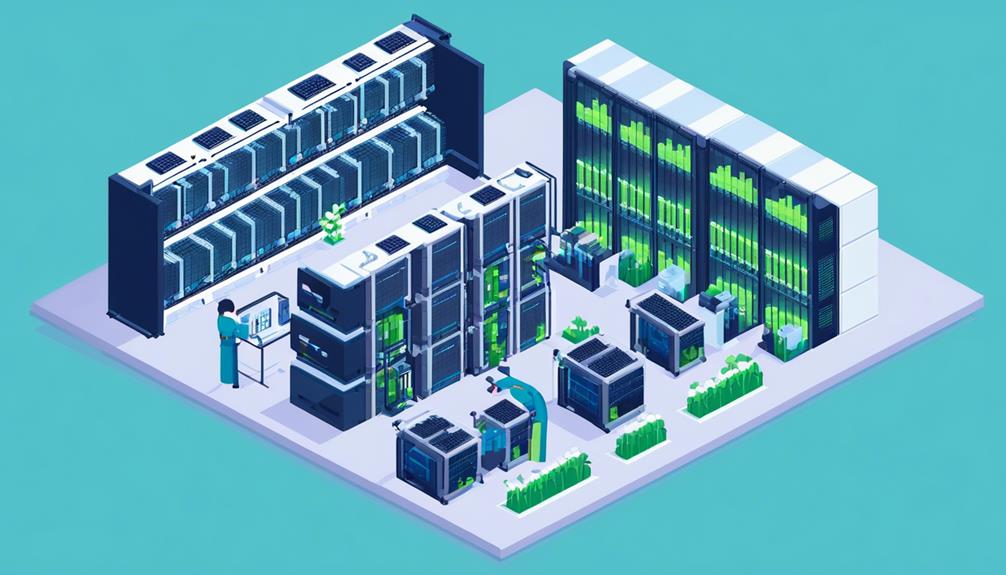
Industry energy standards play a crucial role in promoting energy efficiency in data centers. These standards encompass various initiatives such as:
- Energy efficiency
- Renewable energy adoption
- Monitoring and optimization practices
Energy Efficiency Initiatives
Adherence to established industry energy standards is crucial for data centers aiming to optimize energy efficiency and power management in their operations. Implementing energy efficiency initiatives not only helps reduce energy costs but also contributes to a sustainable and environmentally friendly approach.
To achieve this, data centers can consider the following initiatives:
- UPS Systems: Deploying efficient uninterruptible power supply (UPS) systems can minimize power wastage and improve energy utilization.
- Data Center Infrastructure Management (DCIM): Implementing DCIM solutions provides real-time monitoring and management of power usage, enabling data centers to identify and address areas of inefficiency.
These energy efficiency initiatives, along with adherence to industry energy standards, form a comprehensive approach to power management in data centers. By focusing on energy efficiency, data centers can optimize their operations, reduce costs, and contribute to a greener future.
Renewable Energy Adoption
To further enhance energy efficiency and power management in data centers, a crucial step is to embrace the adoption of renewable energy sources while adhering to industry energy standards. Industry energy standards, such as ASHRAE TC 9.9, The Green Grid, Energy Star, ISO 50001, IEC, and NEMA, provide guidelines for data centers to follow in order to incorporate renewable energy and improve energy efficiency. Compliance with these standards not only helps reduce operating costs but also contributes to environmental sustainability. Data centers can implement renewable energy adoption through strategies like virtualization technologies, power capping, and energy-efficient hardware. Additionally, intelligent power management tools can optimize power consumption in data centers. Understanding power distribution processes and industry energy standards is central to successfully implementing renewable energy adoption and achieving energy usage effectiveness (PUE) goals.
| Industry Energy Standards | ||
|---|---|---|
| ASHRAE TC 9.9 | The Green Grid | Energy Star |
| ISO 50001 | IEC | NEMA |
Monitoring and Optimization
Monitoring and optimization of power usage in data centers is a critical aspect of adhering to industry energy standards and ensuring efficient power management. By actively monitoring power consumption and identifying areas of energy losses, data center operators can implement optimization strategies to reduce operating costs and improve capacity planning.
The following are key considerations for monitoring and optimizing power usage in data centers:
- Use of DCIM (Data Center Infrastructure Management) software to monitor and analyze power consumption in real-time.
- DCIM software provides insights into energy usage patterns and helps identify opportunities for optimization.
- It enables the implementation of power management strategies such as load balancing, equipment consolidation, and temperature control.
Regular assessment of key metrics such as Energy Efficiency Ratio (EER) and Power Usage Effectiveness (PUE) to evaluate power efficiency and identify areas for improvement.
Frequently Asked Questions
What Is Data Center Power Management?
Data center power management refers to the process of monitoring and optimizing power usage in data centers to improve efficiency, reduce costs, and ensure uninterrupted operations. It involves implementing best practices for monitoring and optimizing power usage, addressing challenges such as high energy consumption and limited power capacity.
Renewable energy sources play a crucial role in data center power management, offering sustainable alternatives to traditional power sources.
Future trends in data center power management include the adoption of advanced technologies like artificial intelligence and liquid cooling systems to enhance efficiency and performance.
How Does Power Work in a Data Center?
Power distribution in a data center involves the delivery of power to the IT equipment. This is achieved through a combination of power distribution units, transformers, and power cables.
Backup generators are also installed to provide uninterrupted power supply in case of utility outages.
Cooling systems are crucial for maintaining optimal operating temperatures within the data center.
Power monitoring systems are used to track and analyze power usage, allowing for optimization and efficiency improvements.
To promote energy efficiency, data centers can utilize energy-efficient hardware and integrate renewable energy sources into their power infrastructure.
How Can We Reduce Power Usage in Data Center?
Reducing power usage in data centers can be achieved through various strategies such as:
- Implementing energy efficient hardware
- Utilizing virtualization techniques and server consolidation to optimize resource utilization
- Power monitoring and optimization tools can help identify areas of high power consumption and enable proactive adjustments
Improving cooling system efficiency is crucial in reducing power usage, as well as:
- Integrating renewable energy sources to offset electricity consumption
These measures collectively contribute to a more sustainable and cost-effective power management in data centers.
What Is Power Management in Server?
Power management in servers refers to the process of optimizing energy efficiency and monitoring power consumption in order to achieve server optimization.
It involves load balancing, which ensures that workloads are distributed evenly across servers to maximize performance while minimizing power usage.
Power monitoring and analysis are crucial for identifying areas of improvement and implementing measures to reduce power consumption.
Additionally, virtualization benefits can be leveraged to consolidate servers, further improving energy efficiency and reducing overall power requirements.
